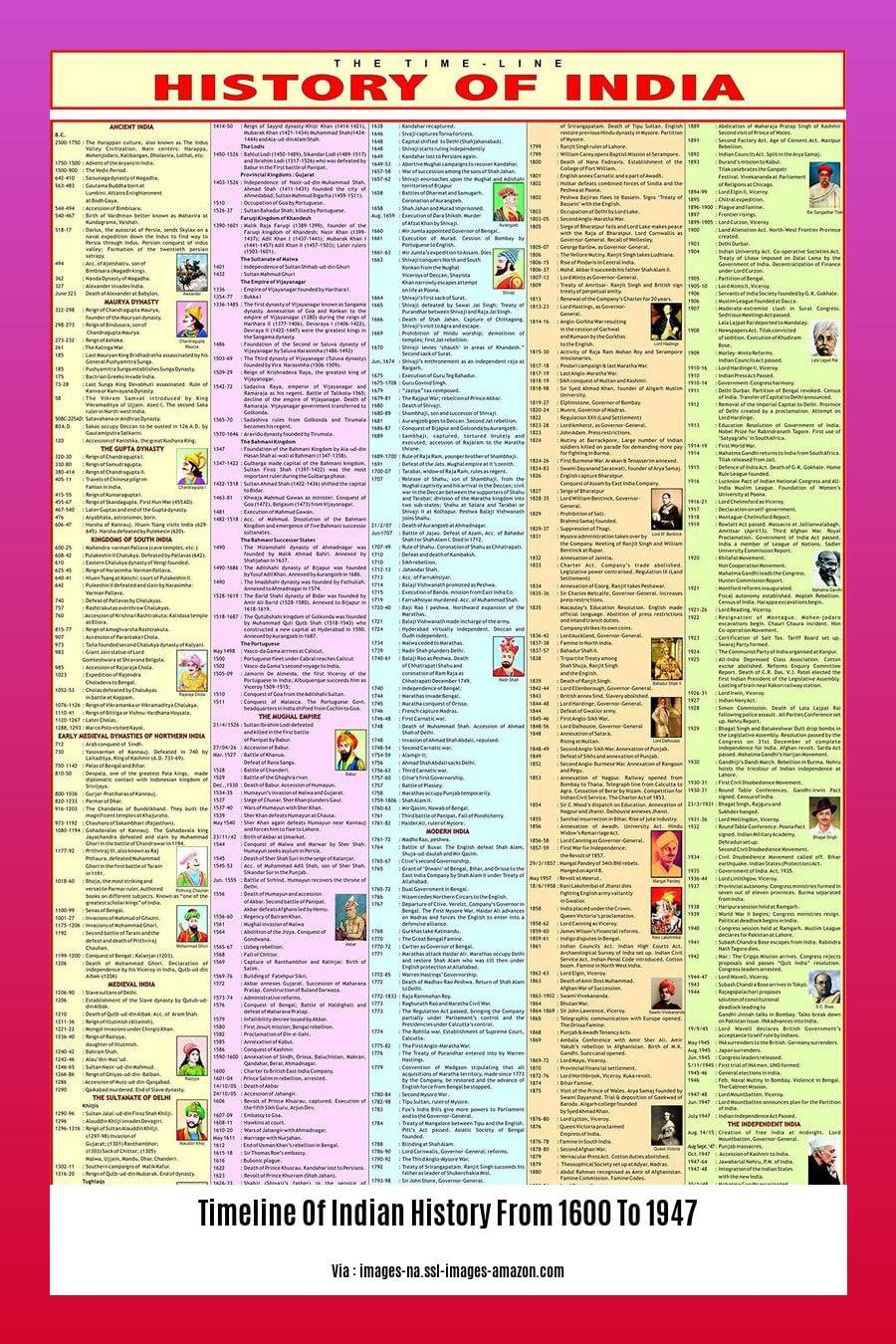Embark on a journey through time as we explore India’s remarkable transformation from 1600 to 1947 in “An Era of Transformation: A Timeline of Indian History from 1600 to 1947.” This comprehensive timeline unveils the pivotal events, influential figures, and dynamic shifts that shaped the Indian subcontinent during this era.
Key Takeaways:
The article covers Indian history from 1600 to 1947, a period of major transformations.
The Timeline of Indian History outlines important legal, territorial, and political events.
In 1947, the Indian Independence Act partitioned India and Pakistan, causing widespread communal violence.
Mahatma Gandhi was assassinated on 30 January 1948.
TakeLessons offers online history tutoring with expert tutors for homework help, exam prep, and coursework.
Students can customize their learning plan, including scheduling, to fit their needs.
TakeLessons’ innovative tutor matching service connects students with instructors tailored to their specific goals.
Timeline of Indian History from 1600 to 1947

1600-1700: The Mughal Empire Ascendant
– The Mughal Empire reaches its zenith under Akbar the Great, ruling over most of the Indian subcontinent.
– Akbar institutes a system of religious toleration and administrative reforms that foster economic growth and cultural exchange.
– The Mughal Empire’s influence extends beyond India, reaching as far as Afghanistan and Central Asia.
1700-1800: The Mughal Empire in Decline
– The Mughal Empire begins to decline after the death of Emperor Aurangzeb in 1707.
– The empire is weakened by internal conflicts and external threats, such as the rise of the Maratha Confederacy.
– The British East India Company takes advantage of the Mughal Empire’s weakness to expand its influence in India.
1800-1900: The British Raj
– The British East India Company becomes the dominant power in India after the Battle of Plassey in 1757.
– The company establishes a system of colonial rule that is often exploitative and oppressive.
– The Indian people begin to resist British rule, culminating in the Indian Rebellion of 1857.
1900-1947: The Indian National Movement
– The Indian National Congress is founded in 1885 to advocate for Indian independence.
– Mahatma Gandhi emerges as the leader of the Indian independence movement, advocating for nonviolent resistance.
– India gains independence from British rule on August 15, 1947, after a long and arduous struggle.
Eager to learn about the journey of Brazilian Jiu Jitsu from its inception to its current status? Dive into the rich history of this martial art here.
Delve into the captivating history of Nigeria from 1914 to the present day here and unveil the nation’s transformative journey.
Explore the significant events that shaped Nigeria’s destiny from 1960 to the present day here and gain insights into the nation’s remarkable transformation.
Embark on a chronological journey through India’s modern history here and uncover the pivotal moments that have shaped the nation’s present.
British East India Company Established

The dawn of the 17th century marked a pivotal juncture in Indian history, as it heralded the arrival of the British East India Company. Imagine yourself transported back in time, to a bustling port city, where ships laden with exotic spices, silks, and precious stones were waiting to be unloaded. Amidst the clamor of bustling markets, a new player emerged, destined to leave an indelible mark on the subcontinent’s destiny.
Imagine, if you will, India’s shores in 1600. The air was thick with anticipation as mariners dropped anchor, their eyes fixed on the land before them. Merchants and adventurers eagerly stepped ashore, their mission – to tap into India’s rich trade and resources. In this vibrant milieu, the British East India Company (EIC) was born.
At its inception, the EIC was nothing more than a fledgling enterprise, a group of audacious traders seeking their fortune in the East. However, as time marched on, it evolved into a formidable force, weaving its way into the fabric of Indian society. It gradually extended its reach, initially engaging in coastal trade but eventually establishing its own territories, particularly in India.
The EIC, with its deep pockets and unwavering ambition, gradually extended its influence, eventually becoming a dominant power in the region. Its tentacles reached every corner of the subcontinent, from the bustling ports of Calcutta to the sprawling plains of the Deccan.
The EIC’s presence in India was a story of both opportunity and exploitation. On the one hand, it introduced new ideas and technologies, transforming the region’s economic and political landscape. On the other hand, its rapacious pursuit of profit led to the colonization of India and the imposition of British rule.
Key Takeaways:
- The British East India Company, established in 1600, began as a modest trading joint-stock company under the protection of a royal charter from Queen Elizabeth I.
- India’s rich trade and resources attracted the company, leading to its expansion from coastal trading to territorial control.
- The EIC’s influence grew steadily, eventually making it a dominant power in India, shaping the country’s political, economic, and social fabric.
- While the EIC brought new ideas and technologies to India, its aggressive pursuit of profit resulted in colonization and the establishment of British colonial rule.
Sources:
World History Encyclopedia: British East India Company
History.com: East India Company
Indian Rebellion of 1857
The Indian Rebellion of 1857 was a defining moment in the history of India, leaving an indelible mark on the relationship between India and Great Britain. Also known as the Sepoy Mutiny, it ignited a spark of independence that would eventually lead to the creation of a modern, independent Indian nation.
Key Takeaways:
- A Clash of Cultures: The rebellion was triggered by cultural misunderstandings, as the use of new cartridges coated with animal fat was perceived as an insult to both Hindu and Muslim soldiers’ religious beliefs.
- Seeds of Resentment: The introduction of a land tax and the annexation of Oudh, a kingdom ruled by a popular nawab, had already created resentment and discontent among the Indian population.
- A Spark Ignites: The rebellion was sparked by a mutiny of sepoys in Meerut on May 10, 1857. It quickly spread like wildfire, with soldiers in other garrisons joining the uprising.
- Delhi Under Siege: The rebels marched on Delhi and captured the Mughal emperor Bahadur Shah Zafar II, proclaiming him as their leader and the symbol of their cause.
- A Bloody Conflict: The British fought back with overwhelming force, leading to a bloody and protracted conflict. The capture of Lucknow and Delhi in 1857 marked a turning point in the rebellion.
- Aftermath and Reforms: The rebellion was eventually suppressed by the British, but it had a profound impact. The East India Company’s rule was abolished, and the British government took over direct control of India.
- Legacy of Resistance: The Indian Rebellion of 1857 became a symbol of Indian resistance to colonial rule, inspiring future generations of freedom fighters.
Relevant URL Sources:
- Wikipedia: Indian Rebellion of 1857
- BYJU’S: Timeline of Important Events During the Indian Freedom Struggle
Indian Independence Movement
A kaleidoscope of dynamic political, social, and cultural shifts transformed India’s landscape from 1600 to 1947. Amidst this era of transformation, a pivotal chapter emerged: the Indian Independence Movement. Join me as I unveil this chapter with a deep dive into the key events that unfurled during these pivotal years.
Key Takeaways:
The Indian Independence Movement represents a series of transformative events that aimed to sever the bonds of British rule in the Indian subcontinent, spanning from 1600 to 1947.
The movement’s genesis can be traced to Bengal, where the spark of rebellion ignited. Subsequently, the movement gained widespread support from the Indian National Congress, a prominent political party established in 1885.
In response to the growing sentiment for self-governance, the All India Muslim League was formed in 1906, championing the interests and aspirations of Indian Muslims.
Scattered acts of resistance and rebellion against British rule had been brewing for decades. Notable among them was the uprising led by Maveeran Alagumuthu Kone in Tamil Nadu.
The movement gained momentum through a series of pivotal events: the partition of Bengal in 1905, the tumultuous period of World War I, and the Non-Cooperation Movement spearheaded by Mahatma Gandhi.
The tireless efforts of countless freedom fighters, coupled with the unwavering determination of the Indian people, culminated in the triumphant attainment of independence on August 15, 1947. This resulted in the establishment of India and Pakistan as sovereign nations.
The Indian Independence Movement stands as a testament to the indomitable spirit of the Indian people. Their unwavering resolve and unwavering desire for self-determination propelled this chapter of history. As we reflect on this momentous struggle, we pay homage to the numerous freedom fighters who dedicated their lives to the cause of independence. Their legacy continues to inspire us today, reminding us of the transformative power of unity, resilience, and the relentless pursuit of freedom.
FAQ
Q1: What significant event marked the beginning of British influence in India?
A1: The establishment of the East India Company (EIC) in 1600, through a joint-stock trading company with a royal charter from Queen Elizabeth I, marked the initiation of British influence in India.
Q2: What was the catalyst for the Indian Rebellion of 1857?
A2: The Indian Rebellion of 1857, also known as the Sepoy Mutiny, was sparked by the refusal of sepoys (Indian soldiers) in the service of the East India Company to use new cartridges rumored to be coated with beef and pork fat, which was considered an offense to their religious beliefs.
Q3: How did the Indian independence movement originate?
A3: The Indian independence movement originated in Bengal and gained momentum with the establishment of the Indian National Congress in 1885, which advocated for self-governance and independence from British rule.
Q4: What were some key events in the Indian independence movement?
A4: Significant events in the Indian independence movement included the Partition of Bengal in 1905, the First World War, and the Non-Cooperation Movement led by Mahatma Gandhi, which marked a turning point in the struggle for independence.
Q5: What was the ultimate outcome of the Indian independence movement?
A5: The Indian independence movement culminated in the formation of the independent states of India and Pakistan on August 15, 1947, marking the end of British rule in India.
- SYBAU See You Baby Meaning: Gen Z Slang Evolves - July 1, 2025
- Unlock Your Inner Youth: Lifestyle Secrets for a Vibrant Life - July 1, 2025
- Decode SYBAU Meaning: Gen Z Slang Explained - July 1, 2025






